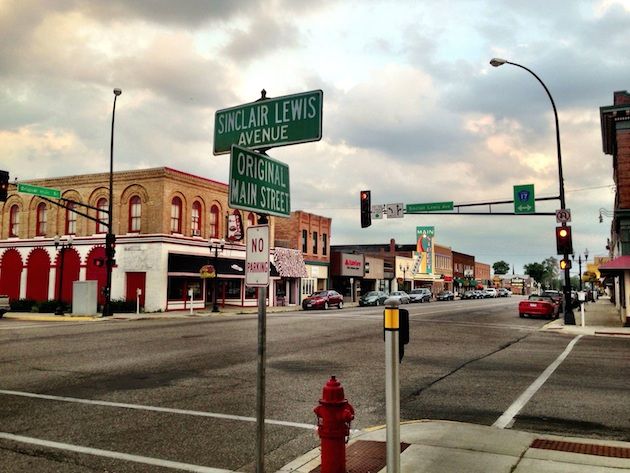
From The Writer's Almanac, the notes on provincialism and the Pulitzer:
And on this day in 1920, the novel Main Street by Sinclair Lewis was published. Lewis had first envisioned a novel about small-town life 15 years earlier. He wrote: "Back in 1905, in America, it was almost universally known that though cities were evil and even in the farmland there were occasional men of wrath, our villages were approximately paradise. They were always made up of small white houses under large green trees; there was no poverty and no toil worth mentioning; every Sunday, sweet tempered, silvery pastors poured forth comfort and learning; and while the banker might be a pretty doubtful dealer, he was inevitably worsted in the end by the honest yeomanry. But it was Neighborliness that was the glory of the small town. I was converted to the faith that a good deal of this Neighborliness was a fake; that villages could be as inquisitorial as an army barracks." Lewis himself had grown up in Sauk Centre, Minnesota, a town of 2,800 citizens. He planned to call his novel The Village Virus, and to make the main character a misfit lawyer. He wrote 20,000 words, but he didn't like it and threw it out.
Then in 1916, he brought his new wife, Gracie, on a visit to Sauk Centre. They stayed with his parents, and he cringed to see some of the interactions between his parents and his modern, well-educated, New York City wife. He decided to rethink the novel so that it centered on a sophisticated young city woman who comes to town as the bride of the local doctor.
It was still a few years before Lewis began working on his novel in earnest. Once he did start, in November of 1919, he wrote his first draft — 221,000 words — in just 14 weeks. He reimagined Sauk Centre as the fictional town of Gopher Prairie. From there, he revised endlessly, and he wasn't shy about chopping out entire scenes or sections — he cut out all but a few pages of the first 30,000 words of this new novel. By early summer, he felt ready to send it to a publisher, his friend Alfred Harcourt, who had just started the new publishing house of Harcourt, Brace and Howe. (Lewis had encouraged Harcourt to start the business, and had bought $2,000 worth of stock to help get it off the ground.) Harcourt and Lewis did a final edit together, and the manuscript was finished by July 1920, just eight months after Lewis had started writing it. The Village Virus was retitled Main Street.
Lewis's previous books hadn't sold very well, but he was optimistic that he could sell 25,000 copies of Main Street. The first printing of 10,000 copies sold out in record time, and Harcourt couldn't get enough paper to meet the demand, so had to publish several smaller printings. Lewis's total sales goal of 25,000 was met by November, and within a few years, Main Street had sold 2 million copies.
In 1921, the Pulitzer committee unanimously recommended Main Street, but the trustees of Columbia University vetoed it and instead chose Edith Wharton's Age of Innocence (1922), which they praised for its "wholesome atmosphere of American life and the highest standard of American manners and manhood." Lewis was annoyed, but he admired Wharton and sent her a sincere congratulatory letter. Wharton wasn't too pleased either, since the trustees thought her novel was praising a way of life she meant to be criticizing; she responded to Lewis: "When I discovered that I was being rewarded — by one of our leading Universities — for uplifting American morals, I confess I did despair. Subsequently, when I found the prize should really have been yours, but was withdrawn because your book (I quote from memory) had 'offended a number of prominent persons in the Middle West,' disgust was added to despair." Two years later, the same thing happened with Lewis's next novel, Babbitt (1922); it was recommended for the Pulitzer, but again it was overruled by the trustees, this time losing to Willa Cather's One of Ours (1922). Lewis wrote in a letter to his father: "I'm quite sure I never shall get the Pulitzer — my books are too critical to please polite committees. [...] Personally I don't care a hang." When he was offered the 1926 Pulitzer for Arrowsmith (1925), he refused it. But in 1930, Lewis became the first American to win the Nobel Prize in literature, an honor that he accepted.
No comments:
Post a Comment
We enjoy hearing from visitors! Please leave your questions, thoughts, wish lists, or whatever else is on your mind.